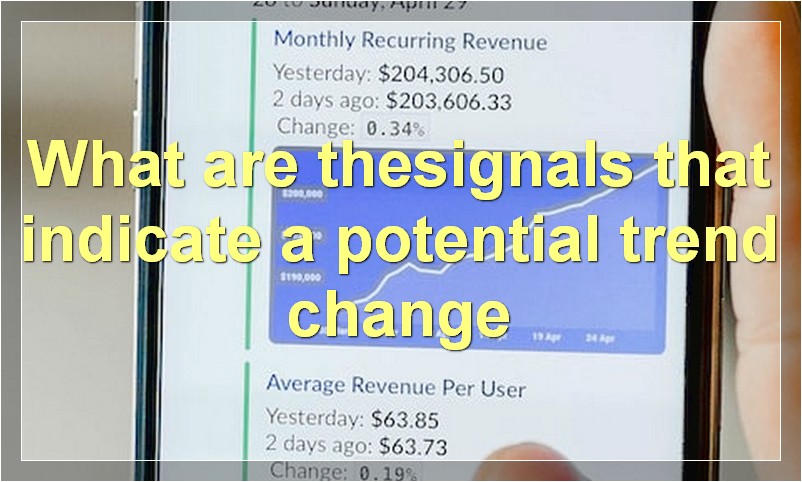Do you want to know what the MACD indicator is and how it can benefit your trading? If so, then read on!
What is MACD
MACD is a technical analysis indicator that stands for Moving Average Convergence Divergence.
MACD is used to help traders identify trend changes and potential reversals by measuring the relationship between two moving averages. MACD is calculated by subtracting the 26-day exponential moving average (EMA) from the 12-day EMA.
The MACD line is the difference between the MACD line and signal line. The signal line is a 9-day EMA of the MACD line. Traders may buy when the MACD crosses above its signal line or sell when it crosses below the signal line.
MACD is a popular indicator because it is easy to interpret and can be used in conjunction with other technical indicators to form a trading strategy.
How is MACD calculated

The MACD (Moving Average Convergence Divergence) indicator is a technical analysis tool that uses the difference between two exponential moving averages (EMA) to gauge momentum and spot trend changes.
The MACD is calculated by subtracting the 26-day EMA from the 12-day EMA. This calculation gives us the MACD line. A signal line is then created by calculating the nine-day EMA of the MACD line, and this is plotted on top of the MACD line. The point where the two lines intersect is called the centerline.
MACD signals are generated when the MACD line crosses above or below the signal line, or when it diverges from the signal line. A bullish MACD crossover occurs when the MACD line crosses above the signal line, and a bearish crossover occurs when the MACD line crosses below the signal line.
A bullish divergence occurs when the MACD line diverges from the signal line in a downward direction (i.e., the MACD line is sloping downward while the signal line is sloping upward), and a bearish divergence occurs when the MACD line diverges from the signal line in an upward direction (i.e., the MACD line is sloping upward while the signal line is sloping downward).
What are the components of MACD
The moving average convergence divergent (MACD) is a momentum indicator that shows the relationship between two moving averages of prices. The MACD is calculated by subtracting the 26-day exponential moving average (EMA) from the 12-day EMA. A nine-day EMA of the MACD, called the “signal line”, is then plotted on top of the MACD, functioning as a trigger for buy and sell signals.
MACD signals are generated by looking for crossovers and divergences between the MACD line and signal line. A bullish crossover occurs when the MACD line crosses above the signal line, while a bearish crossover occurs when the MACD line crosses below the signal line. A bullish divergence occurs when the MACD line forms two higher lows while the underlying security forms two lower lows, while a bearish divergence occurs when the MACD line forms two lower highs while the underlying security forms two higher highs.
What do the MACD line and histogram represent
The MACD line is the difference between the fast moving average and the slow moving average. The histogram is the difference between the MACD line and the signal line.
How can MACD be used to identify market trends
The MACD is a technical indicator that is used to identify market trends. The MACD is calculated by subtracting the 26-day exponential moving average (EMA) from the 12-day EMA. A 9-day EMA of the MACD, called the “signal line”, is then plotted on top of the MACD, and acts as a trigger for buy and sell signals.
MACD buy signals occur when the MACD line crosses above the signal line. MACD sell signals occur when the MACD line crosses below the signal line. The MACD can also be used to identify overbought and oversold conditions in the market. An overbought market occurs when the MACD is above 0.80, and an oversold market occurs when the MACD is below -0.80.
What are thesignals that indicate a potential trend change

When it comes to analyzing potential trend changes, there are a few key signals that you can look for. Here are a few of the most important ones:
1. A change in price direction. This is perhaps the most obvious signal that a trend may be changing. If the market has been moving in a certain direction for some time and then starts to move in the opposite direction, it could be an indication that a change is coming.
2. A change in volume. Another important signal to watch for is a change in volume. If there is suddenly more or less activity in the market, it could be an indication that a trend change is imminent.
3. A change in momentum. Momentum can be measured by indicators like the Relative Strength Index (RSI) or the Stochastic Oscillator. If these indicators start to show a reversal, it could be an indication that the current trend is about to change.
4. A break of support or resistance. Support and resistance levels are key areas where the market has trouble breaking through. If the market breaks through a key level, it could be an indication that a new trend is beginning.
5. Divergence. Divergence occurs when the price action and indicators are not moving in the same direction. This can be a sign that the current trend is losing steam and may soon come to an end.
Of course, no single signal is guaranteed to indicate a trend change. However, if you see several of these signals occurring at the same time, it could be a good indication that a change is coming.
Can MACD be used to measure overbought and oversold conditions in the market
The MACD is a technical indicator that can be used to measure overbought and oversold conditions in the market. The MACD stands for Moving Average Convergence Divergence. The MACD is calculated by subtracting the 26-day exponential moving average (EMA) from the 12-day EMA. A nine-day EMA of the MACD, called the “signal line”, is then plotted on top of the MACD line, which acts as a trigger for buy and sell signals.
Overbought and oversold conditions are defined when the MACD line diverges from the signal line. A buy signal is generated when the MACD line crosses above the signal line, and a sell signal is generated when the MACD line crosses below the signal line. TheMACD can also be used to identify divergences, which often occur before reversals in the market. A bullish divergence occurs when the MACD line forms higher lows while prices are forming lower lows. This indicates that momentum is shifting from bearish to bullish, and a reversal may be imminent. A bearish divergence occurs when the MACD line forms lower highs while prices are forming higher highs. This indicates that momentum is shifting from bullish to bearish, and a reversal may be imminent.
The MACD is a versatile tool that can be used in a variety of ways to help traders make better informed decisions about when to buy and sell in the market.
What other indicators can be used in conjunction with MACD to provide trade signals
Other indicators that can be used in conjunction with MACD to provide trade signals include the Relative Strength Index (RSI) and the Moving Average Convergence Divergence Histogram (MACDH).
The RSI is a momentum indicator that measures whether a stock is overbought or oversold. A stock is considered overbought when the RSI is above 70 and oversold when the RSI is below 30.
The MACDH is a technical indicator that uses the MACD line and the signal line to generate trade signals. A buy signal is generated when the MACDH crosses above the signal line and a sell signal is generated when the MACDH crosses below the signal line.
Does the use of MACD guarantee success in trading
No, the use of MACD does not guarantee success in trading. However, many traders believe that MACD is a helpful tool that can give them an edge in the markets. MACD is a technical indicator that measures the difference between two moving averages. It is used to identify trend changes and can be used to generate buy and sell signals.
What are the risks associated with using MACD as a trading indicator
The risks associated with using MACD as a trading indicator are that it is a lagging indicator, which means that it can give false signals, and that it is subject to interpretation.

